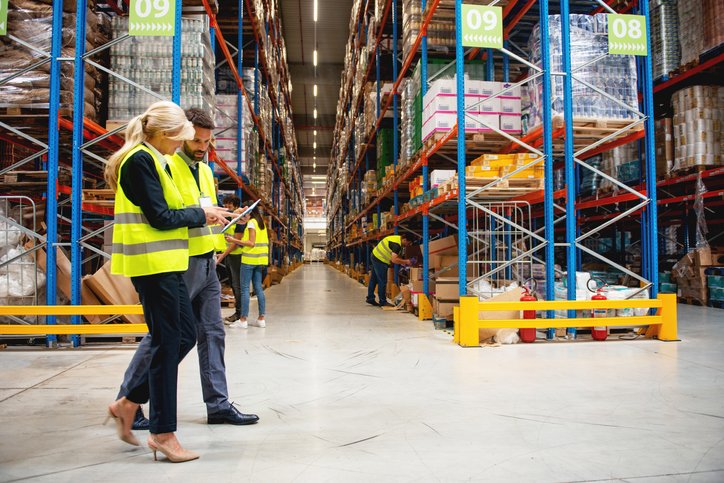Asset tracking has always been an important part of cost-effective warehouse and facilities management. As warehouses expand in size and complexity, more managers are recognizing the value of an asset tracking app.
Asset tracking solutions have evolved by necessity to include more robust mobile capabilities. However, while 30% of warehouse managers believe increased asset visibility and utilization will become the most important operational outcome in the next five years, according to a Warehouse Vision study, 77% admit they are slow to implement new devices and technology.
They cite a variety of reasons, including the financial commitment and the time it takes for testing and training staff to use new tools.
Others may not realize how much time and additional costs they can save by using asset tracking apps.
How an asset tracking app benefits warehouses
Asset tracking apps enable warehouses to track asset locations, manage the life cycle of all assets, and create accurate use reports based on performance analytics. Here are a few reasons why an asset tracking app is an essential investment for today’s modern warehouses.
1. Gain full control of your assets
Large warehouse operations often have multiple locations and hundreds or even thousands of employees. As result, they are particularly vulnerable to disruption caused by the loss or misplacement of critical assets. If a team member can’t find what he or she needs to get the job done, the delay can be costly.
The trickle-down effect creates losses in many other areas of warehouse operations as well, including production efficiency and supply chain relationships. These are losses enterprises can rarely afford.
While warehouses have developed a wide range of strategies to support the mobile-enabled workforce, few have implemented effective policies to control and track their increasingly mobile asset base. Assets often move both within an organization’s built environment as well as outside of it.
This mobility gives modern warehouses many advantages. For example, they don’t have to invest in multiple pieces of equipment, because they can share them among many parts of the business and many locations, or even with third parties when they have a reliable tracking method in place. Sharing assets helps warehouses maximize the use of their investments, especially with high-cost specialty equipment.
2. Locate your assets in real time
Operators need to know the locations of all of their assets in real time so they can put them to use where and when they need them.
A barcode reader alone is no longer sufficient to effectively track assets in the increasingly mobile warehouse environment. Instead, an integrated asset tracking app enables continual asset tracking, which supports the overall goal of gaining operational efficiencies.
Real-time capability gives managers visibility and control over all assets wherever they are. When operations or maintenance teams are looking for a particular asset, they should be able to pull up the record and quickly see exactly where it is and its life cycle details.
3. Reduce maintenance costs
Most warehouses rely on a portfolio of equipment that they source from around the world. This equipment is often expensive and sometimes difficult to replace. The replacement costs of even a few assets can end up making the difference between profitability and barely breaking even. That’s why maintenance must be a top priority.
Larger assets like warehouse machinery require regular maintenance to meet production expectations and to keep team members safe. However, warehouses’ operational budgets are shrinking, and equipment maintenance and repair costs are on the rise. Many warehouses aim to stay on top of equipment repairs as they occur, but most want to move to the next level by proactively predicting equipment wear and tear before a piece of equipment breaks down.
The goal is to get maintenance costs under control and keep equipment in top shape so the warehouse can maximize its uptime. To achieve this, warehouses must look for ways to get the most out of their assets and plan for—or avoid—failures.
Sophisticated asset tracking apps provide a better way to organize equipment maintenance schedules. The most advanced solutions help managers predict equipment failure before it occurs, so warehouse maintenance teams can time preventive maintenance with more precision.
Warehouses gain several cost-saving and production-boosting benefits from automated equipment maintenance management, including:
- Staying on top of scheduled maintenance. Equipment maintenance schedules can easily slip in the day-to-day demands of busy warehouses. But deferring maintenance can result in a much higher risk for equipment failure and lost production. Asset management platforms overcome these risks by organizing equipment maintenance schedules and delivering automatic notifications.
- Proactively predicting equipment repairs. Using collected data provided by an asset tracking app, warehouses gain access to predictive insights, so they can identify potential problems before equipment breaks down. For example, an asset tracking app can discover that a compressor is using more energy than normal, which might cue a team to inspect the unit, even if maintenance isn’t already on the regular schedule. This proactive approach enables warehouses to optimize productivity and lower repair costs.
- Tracking equipment warranties. In a busy warehouse, it’s all too easy to lose track of equipment warranty data. Asset tracking apps can store this important information so it’s always available. Mobile apps provide easy access to accurate records of equipment under warranty and send alerts when work orders are created. As a result, warehouses save by avoiding repair costs of equipment that’s still under warranty.
4. Uncover big-picture trends
The warehouse floor is constantly evolving. To keep up with production demands, leaders need to be aware of changes as they happen—even when the changes are gradual over time. But tracking day-to-day operations in the context of future demands can be difficult, if not impossible, for warehouses that are not equipped with data insight.
The challenge for warehouses is to identify patterns that indicate where changes should be made today to help make their operations more efficient and more cost effective tomorrow.
Warehouses need constant visibility into their assets on the floor and ways to visualize their needs for the future. An asset tracking app is a great solution for compiling data in a way that helps to keep operations running more reliably and efficiently.
Modern asset management platforms deliver an effective solution for these challenges by providing warehouses with a range of custom reporting capabilities. For example, they can produce total-cost-of-ownership reports, dashboards that display the percentage of maintenance work that’s on-schedule, anticipated need for repair parts and more.
A modern platform should also provide practical metrics that inform budget discussions. For example, asset management solutions should be able to track patterns in asset usage. This makes it easy to record information such as who is using a particular item at any given time, how often it’s being used, and how much it’s in demand.
In this way, warehouses can make smarter equipment purchasing decisions based on actual needs. This insight also prevents purchasing items that aren’t truly needed, preventing wasteful spending.
Meeting new requirements in asset management
ManagerPlus is at the forefront of asset management software with the ManagerPlus Lightning platform. We continue to bring warehouses and facilities the features that are revolutionizing the asset management industry. That includes:
- The ability to easily track assets by location. You can connect your devices to ManagerPlus Lightning to gain critical insight into operations and enable managers to allocate resources with maximum ease and efficiency.
- Automated notifications for preventive maintenance. Our Lightning asset management app notifies warehouse managers and team members when it’s time to perform maintenance based on your preferred schedule and work history.
- Expanded data analytics. Get a snapshot of today and plan for the future with powerful reporting and dashboard capabilities.
Schedule a customized demo to see how ManagerPlus Lightning can take your maintenance and asset management to the next level.




